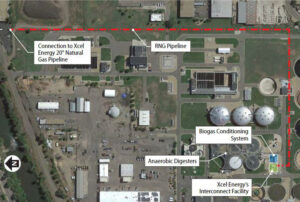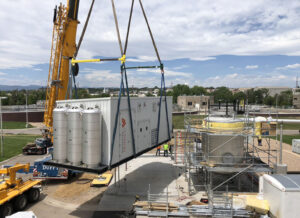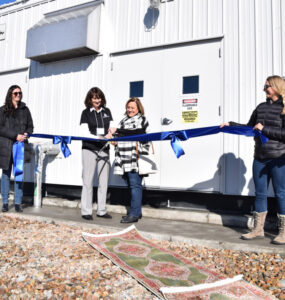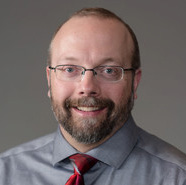South Platte Renew (SPR) is a regional wastewater facility serving approximately 300,000 people in and around the cities of Littleton and Englewood, Colorado. As part of its energy optimization activities, it recently installed a gas recovery facility that allows it to capture the methane that is created as part of the wastewater treatment process, purify it, and sell it to Xcel Energy. In addition to the money it gets from Xcel, this earns SPR significant credit from federal and state renewable fuel standard programs. In this interview, SPR Director Pieter Van Ry tells Municipal Water Leader about the genesis of the program and his advice for other utilities that are interested in a similar initiative.
Municipal Water Leader: Please tell us about your background and how you came to be in your current position.
Pieter Van Ry: I’ve spent 25 years in the water, wastewater, and storm water field. I have an undergraduate degree in engineering from the State University of New York College of Environmental Science and Forestry in Syracuse and an executive MBA from the University of Denver’s Daniels College of Business. I began my career in engineering consulting, and after about 10 years, I made the transition to the public sector as the engineering manager of a water utility. I progressed from engineering manager to engineering director, and a little over 2 years ago, I became the director of SPR. In March 2020, I also became the director of the City of Englewood’s utilities. SPR and the utilities department are two distinct and separate organizations that are housed under the city umbrella.
Municipal Water Leader: Please tell us about SPR.
Pieter Van Ry: SPR is a regional wastewater facility that is a 50/50 joint venture between the Cities of Englewood and Littleton. In the late 1970s, each city had its own separate wastewater treatment plant, each of which required a significant number of upgrades. The U.S. Environmental Protection Agency worked with the two cities to combine those plants into a regional facility. The regional facility serves those two cities, which have a combined population of about 80,000, as well as a number of connector sewer districts, or communities outside the two cities, bringing the total population we serve to about 300,000 people. Our service area is about 108 square miles in size.

Municipal Water Leader: What sort of infrastructure do you manage?
Pieter Van Ry: We are a wastewater treatment facility only. Our property is about 53 acres in size, and everything inside the fence belongs to SPR. We don’t have large interceptors or anything like that. The site has about 25 buildings and approximately 50 process tanks. Our current rated capacity is 50 million gallons per day. We’re an advanced tertiary wastewater treatment facility with a liquid stream, a solid stream, and a gas stream. Our main wastewater treatment processes include primary clarification, trickling filter treatment, secondary clarification, tertiary nitrifying trickling filter treatment, denitrification filter treatment, solids handling, and disinfection.
Municipal Water Leader: What was the motivation behind the creation of your gas recovery facility and pipeline injection project?
Pieter Van Ry: Several decades ago, SPR developed an interest in trying to recover the methane gas stream that is created as part of the wastewater treatment process. In the 1990s, we installed two 1‑megawatt engine generators to offset electricity use and used the gas to power those generators. However, the gas was so dirty that it was not a reliable fuel source and fouled the engines. Ultimately, that project was abandoned after a significant investment.
In 2012, an internal workgroup focused on energy sought to identify ways to improve energy optimization at the facility.
The first project the team came up with was the biogas recovery project. In 2016, we hired an outside consultant to perform a biogas feasibility study. The consultant considered a number of potential uses for biogas and ultimately landed on direct pipeline injection. We’re fortunate because a main Xcel Energy transmission line runs along the northern boundary of our property, meaning that very little pipeline infrastructure was needed to connect to the main transmission line. That made it an attractive project for us.
The Renewable Fuel Standard program was also a significant driver for this project alternative. That federal program assigns renewable identification numbers (RINs), which provide credit for gas that offsets the use of transportation fuels. Whenever we can inject our renewable natural gas into the pipeline and offset the use of fossil fuels, we gain a revenue credit.
Based on those factors, the team decided that the pipeline injection project was the best project for us to move forward with. Once that determination was made, we held several meetings with our two city councils to get their support for and approval of the project and then moved forward with design and construction. The facility finally came online on October 31, 2019.
Municipal Water Leader: How much methane gas is created by the treatment process, and what happened to it before the building of this facility?
Pieter Van Ry: We generate approximately 470,000 cubic feet of digester gas per day, which is equivalent to about 2,060 gallons of gasoline. We report that equivalency because of our involvement in the transportation fuels program. That is the amount of gasoline that our project offsets every day. Prior to the project, 40 percent of that digester gas was used to fire our boilers to help with the digestion process. The other 60 percent was flared off into the atmosphere. We now recover almost all of that gas, clean it, and inject it directly into the Xcel natural gas pipeline.
Municipal Water Leader: Please tell us about the recovery and cleaning process.

Pieter Van Ry: The majority of the process occurs in a system housed in a unit about the size of a shipping container that is positioned on a skid. In it are a number of cleaning mechanisms that remove impurities from the gas. The system includes a hydrogen sulfide scrubber, a moisture removal process, heat exchangers that chill the gas, a compressor that compresses the gas, and an oil separator that removes oil from the gas. Throughout the cleaning process, the temperature is adjusted several times to optimize the removal of the contaminants. We then remove siloxanes, volatile organic compounds, and carbon dioxide. The clean gas goes through a gas meter and is injected directly into the Xcel pipeline. A small amount of tail gas, which contains the remaining concentrated contaminants, is directed to a device called a thermal oxidizer, where it is eliminated.
The cleaning and recovery process is not terribly energy intensive. We conservatively estimated that the annual operating cost of the system would be about $550,000. After a year of operation, data suggest that the actual cost might be even lower, although we don’t have enough information yet to make a firm determination.
Municipal Water Leader: Is SPR paid by Xcel Energy for the gas it provides?
Pieter Van Ry: Yes, we are paid by Xcel for the gas we inject, but that’s not how we generate the majority of our revenue. We actually access three revenue streams for the renewable natural gas we produce at our facility. The selling of the brown gas to Xcel accounts for about 5 percent of the revenue that we generate from the gas. The remaining revenue streams come from federal and state programs that help offset fossil fuel usage and greenhouse gas emissions. The renewable fuel standard program accounts for around 60 percent of the total revenue. During our first year of operation, we also successfully applied for the California low-carbon fuel standard program, which allows us to sell our gas for additional credit. This additional program revenue will account for about 35 percent of our 2020 biogas revenues.
Municipal Water Leader: Do you have any advice for other wastewater service providers that might be considering a similar project?
Pieter Van Ry: First, get your data and facts together to develop a sound rationale for the project. Once you have that documented, get your city council or board and the members of your community who support the project involved. In our case, a citizen group called Citizens Alliance for a Sustainable Englewood was interested in this project because of its renewable nature and its focus on sustainability. It showed its support for the project publicly and advocated for the council to move it forward. Our councils also showed ongoing support for the project as it developed. Backing from the councils and the community in the early stages of the project is extremely helpful as you progress through the more technical challenges that lie ahead.
Getting a broker on board is important. We’re a wastewater treatment facility, so oil and gas are not our areas of expertise. We hired a broker to assist us with our project development and to guide us through the appropriate regulatory processes. It is also a critical support for us as we market and sell the gas, ensuring that we’re optimizing the timing of when we sell into the system to maximize our revenues.
I also recommend establishing a strong, early connection with the gas utility that will be receiving the gas. Gas utilities have stringent standards for their pipelines that do not typically account for the type of renewable natural gas that is produced by wastewater treatment plants. Many of the existing testing procedures used by the gas company made it difficult to actually sell our renewable gas into the pipeline. We worked with the utility over the course of a year to negotiate requirements for our gas that allowed us to inject while also ensuring that its systems were protected.
Another recommendation is always to get your operations staff involved in the project early. In our industry, we’re really good at handling water treatment and solids, but gas is a whole new arena. Getting the operators involved in the gas recovery operation early and especially during system startup and commissioning helps you achieve success faster.
Finally, I would say to be patient and to remember that it’s a long-term investment. It takes time for staff to develop an understanding of this process, and it takes time to recoup your costs. The original cost of this project was about $7.8 million. Based on our revenue projections, we anticipate making that money back in 4–7 years. Actually, based on the current RIN pricing, we’re estimating about a 5½-year break-even point for the system. You can make the economics of this type of project work out fairly well in your favor if you’re able to keep the costs down and as long as the renewable fuels programs stays in place. Either way, the project is still a significant benefit to our community because the gas is no longer just flared into the atmosphere.
Municipal Water Leader: What are the other top issues that SPR is working on today?

Pieter Van Ry: Nutrient standards are something that we’re always planning for. Some significant nutrient standards are currently affecting us and will continue to affect our facility over the next 15–20 years. We’re planning for those future standards right now, because they will not just require a couple million dollars of investment, they’ll require hundreds of millions of dollars’ worth of upgrades. We are planning now so that by the time we need to pull the trigger on those projects, we will have the funding in place and know the technical approach we are going to take to meet the challenge.
PFAS contaminants are a huge issue that continue to gain regulatory focus nationally and could affect wastewater treatment. These contaminants, sometimes called forever chemicals, are contained in firefighting foam, nonstick coatings, clothing, and many other everyday materials. They’re hard to remove from wastewater, and we don’t know what that’s going to mean for our future treatment process requirements.
Like a lot of utilities across the country, we’re also continually trying to balance funding the replacement of aging infrastructure with maintaining rate stability. One of our biggest challenges is to plan for the unknowns of future regulations and how they will affect our treatment processes. When we focus on solving this problem strategically, we are able to minimize the potential for significant rate increase shock to our customers. This is something that we emphasize when developing our long-term financial plans.
The final issue is staffing. We seek to recruit the best and most highly qualified talent for our organization. The workforce is changing, and we are rapidly losing our most experienced workers to retirement. Utilities across the nation are finding that that a significant amount of institutional knowledge is walking out the door, leaving our new people to figure things out without a lot of guidance. We focus a lot of our time and energy on this transition.
Municipal Water Leader: What is your vision for the future of SPR?
Pieter Van Ry: For me, there are two aspects to this question. I want our organization to be an active leader in innovation in the wastewater industry. I see that occurring through partnerships with colleges and universities as well as with manufacturers, technology providers, and engineering design firms. I want us to be a strong partner in developing new technologies to help solve the problems that are 10, 15, or 20 years down the road. If we take an active role in helping advance innovation in our industry, we will ultimately save our customers money in the long run.

The other focus for me is on the organizational or people side of our business. At our organization, we’re focused on developing a culture of excellence. I believe that that ultimately comes down to having people enjoy where they work. I want people to love to come to work. If they love what they do, they’ll work harder and be more engaged and dedicated to this organization. All the technical challenges will be addressed one way or another. It’s the environment and the culture that we create that will separate us as an organization and make us successful.
Pieter Van Ry is the director of South Platte Renew and of the City of Englewood’s utilities. He can be contacted at pvanry@englewoodco.gov.

